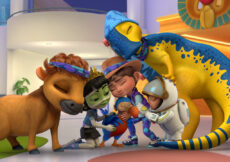Anxiety disorders are mental health disorders characterized by excessive worry about events and everyday situations. They can impact children’s normal functioning both at home and school, and the feelings of fear and anxiety can cause physical and emotional symptoms such as nervousness, rapid heartbeat, and panic in children.
Everyone is born with a natural “fight or flight” response to survive threats and predators. In stressful situations, the brain area controlling this response can trigger nervousness, fear, and anxiety.
Although it is normal for children to experience fears and anxiety occasionally, children with anxiety disorders can have extreme feelings of fear and worry without valid reasons.
Read this post to know about the types, causes, symptoms, complications, diagnosis, and treatment of anxiety disorders in children.
Types Of Anxiety Disorders In Children
Several types of anxiety disorders are seen in children, and a child may have more than one type at a time. These may include
- Generalized anxiety disorder
Children with generalized anxiety disorder may manifest persistent, unrealistic, and excessive fears that are not focused on a particular situation or object. For example, they may have worries about their school performance or any other activity. In addition, some children may fear for the safety of their family members or about natural disasters.
Children with this disorder can constantly worry, which can affect their concentration, learning, and other social interactions. They may also seek frequent reassurance due to their insecure feelings.
- Obsessive-compulsive disorder
Children with obsessive-compulsive disorder (OCD) may have intrusive, unwanted thoughts (obsessions) that can cause anxiety and make them perform repetitive actions, routines, or rituals such as counting, organizing objects in a specific manner, washing hands frequently, and reading something repeatedly.
Their compulsive thoughts may interfere with their daily functioning and often cause them embarrassment and distress.
Extreme fear or discomfort when in certain places or situations can cause panic attacks in some children. Panic disorder may cause symptoms such as tingling sensations, pounding heart, and shortness of breath in children. Children with anxiety can have panic attacks in extremely fearful situations, but children with panic disorder may have panic attacks without obvious triggers. This may interfere with their normal activities, especially if the child worries about future panic attacks.
Certain fears are common in children, and most children outgrow them when they mature. However, some children may have a severe, intense, and irrational fear of a situation or object. This may not decrease even when you offer them reassurance and usually develops as early as five years of age. Specific phobias may include fear of animals, thunder, driving, heights, crowd, elevators, and medical or dental procedures.
Also called social phobia, this is an excessive fear of being embarrassed, humiliated, or rejected in a social setting. Children with social phobia may have issues speaking in front of a group, talking to peers or adults, joining in conversations, or eating in public.
Social anxiety may also make them fearful about making friends or interacting with strangers. Some children or adolescents may have a fear of social events and dating, although they may be confident in academic and work environments.
- Separation anxiety disorder
Significant fear of being away from home, parents, or caregivers is the hallmark of separation anxiety disorder. Children with this disorder may show extreme clinginess, which may affect their ability to function normally. They may refuse to go to playgrounds, schools, or even sleep without a parent or the attachment figure.
Children with selective mutism may speak freely in familiar situations but become mute in specific situations or around others. Refusing to communicate and avoiding eye contact with others are common in children with selective mutism. This is common in preschool-age and elementary school-age children.
You may seek medical care to identify the types of anxiety disorder in children. Some children may have more than one type, and the treatment options may vary depending on the severity and type of anxiety.
Risk Factors And Causes Of Anxiety
The exact cause of anxiety disorders is not known. However, genetic and environmental factors may play a role in the development of anxiety in children. The following factors may be linked to anxiety in children.
- Genetic factors: Some children may inherit anxiety from their parents. Research suggests that one-third of generalized anxiety disorder has a genetic link.
- Temperament factors: Children with shy temperaments or who avoid dangerous things are more prone to anxiety disorders than others.
- Biological factors: Disruption to the neurotransmitters (brain chemicals) such as serotonin and dopamine can cause depression and anxiety.
- Environmental factors: Anxiety disorders can be triggered by a traumatic event in For example, parental conflicts or divorce, illness, death in the family, school-related issues such as bullying or exams, abuse, neglect, and serious illness or injury may lead to anxiety in children. Constantly moving school or house can also be a reason for anxiety in children.
Some children may learn anxious behaviors from family members or others around them. Furthermore, children with autism spectrum disorders and attention deficit hyperactivity disorders (ADHD) are also at an increased risk for anxiety problems.
Symptoms Of Anxiety In Children
Anxiety disorders can cause emotional and physical symptoms in children. The common physical symptoms seen in children with anxiety disorders may include
Children with anxiety may also have the following emotional symptoms.
- Worrying that something bad will happen to them or their loved one
- Need for perfection in everything
- Worrying about school performance and other activities
- Constant fear and thought about the safety of self, family, and friends
- Clingy behavior with caregivers or parents
Seek pediatric help if your child has any of these symptoms.
Symptoms Of Anxiety At School
Anxiety can also result in poor academic performance due to concentration issues and learning problems. Anxiety in the classroom can be difficult to identify and can often be confused with angry or disruptive behavior, stomach upset, ADHD, or learning disorders.
Inattention, difficulty answering questions, not completing homework, and poor performance in team activities are some common symptoms of anxiety in the classroom.
Complications Of Anxiety In Children
If left unmanaged, anxiety disorders can worsen mental and physical conditions in children and also affect their social wellbeing. The common complications of anxiety in children may include
- Insomnia (trouble sleeping)
- Poor academic performance
- Bowel or digestive problems
- Chronic pain and headache
- Social withdrawal or isolation
Diagnosis Of Anxiety Disorders
The American Academy of Child and Adolescent Psychiatry (AACAP) recommends screening of anxiety symptoms, their severity, and functional impairment due to anxiety while diagnosing the condition and assessing and excluding general medical conditions such as hyperthyroidism and mental health disorders that may mimic anxiety symptoms in children.
Child psychiatrists may talk with the child and family members to know the symptoms. The doctors may also compare your child’s symptoms with criteria set in the American Psychiatric Association Diagnostic and Statistical Manual of Mental Disorders (DSM-5) to diagnose anxiety disorders.
Laboratory tests and other diagnostic evaluations are usually ordered to exclude any other possible causes of similar symptoms.
Treatment For Anxiety Disorders
Doctors may suggest a treatment depending on the cause of anxiety disorder and the age of the child. Counseling may help children understand and work through anxious situations. The following treatment options are usually recommended for children with anxiety disorders.
- Cognitive-behavioral therapy (CBT): This involves providing psychoeducation to the child and caregivers or parents to help them understand and manage the condition. The therapy can also help a child change the thoughts that provoke anxiety symptoms.
- Anti-anxiety (anxiolytic) medicines: In the case of severe anxiety disorders, the child may require anti-anxiety drugs along with CBT or other psychotherapies. Fluoxetine, sertraline, tricyclic antidepressants (TCAs), and benzodiazepines are common medications prescribed for anxiety disorders in children. These medications should be prescribed solely by a child psychiatrist based on the child’s age and symptoms.
Natural Anxiety Medications For Anxiety Disorders
Regular sleep, physical activity, relaxation techniques, and a healthy diet may help reduce anxiety in some cases. However, psychotherapies and medications can be more beneficial. Some herbal medications are also known to reduce anxiety. However, more studies are required to evaluate their risk and benefits. These medications may include
Dietary and herbal supplements are not monitored by the Food and Drug Administration (FDA) as drugs. So, you can’t be sure about the safety of many of these medications. It is recommended to inform the child’s doctor before giving alternative medications since some can interfere with prescription medications.
How To Help A Child With Anxiety?
Parents and teachers have a crucial role to play in the management of anxiety in children. The following tips may help a child manage and overcome anxiety:
- Teach your child to manage anxiety: You may help your child overcome anxiety rather than trying to remove the triggers. When the child learns to manage their anxiety, they can gradually overcome it and function well.
- Provide them with reassurance: Do and say things that would boost their confidence. You may assure them that they won’t fail a test, or no one will laugh at them while speaking in front of a crowd.
- Never reinforce fears: If your child has fears, never reinforce them. You may avoid saying to your child certain things they are afraid of. Your tone of voice and body language can also unknowingly send wrong messages to children and trigger fears. You may try to avoid any verbal or nonverbal cues that may trigger their fears in any circumstances.
- Avoid leading questions: Let your child talk about their feelings and fears. Never ask them leading questions such as “Are you anxious about exams? “since this may trigger a cycle of anxiety in some children. You may rather ask them open-ended questions such as “How do you feel about the exams?”
- Keep a short anticipatory period: Most children are anxious before they do something rather than when they are facing it. Try to keep the anticipatory period short. For example, if a child is scared to visit the doctors, do not let them know too early that they have an appointment. Early discussions can raise anxiety levels.
- Respect the child’s feelings: Never assume that the child’s fears are silly, and do not amplify them either. You may listen to them and help them understand their fears. Be empathetic and say “I know you are worried, and it is normal, and I am here to help you get through this. “These statements may help your child face the situation with confidence and know that you are there for them when they need help.
- Talk to the child about the results if their fear comes true: Sometimes, it can be helpful to talk to your child about their fear and discuss what they can do if the fear comes true. Having a plan may help reduce anxiety in some children.
Anxiety may lock up the brain, and children may often face hard times in school. You may inform your child’s teachers about the condition. This may help the teachers understand the child’s condition and help them gradually overcome their classroom anxieties.
Children with extreme fear of something that affects their social and academic life should be evaluated by an expert since this can be due to an anxiety disorder. Some cases may go unnoticed if parents consider these problems to be due to low intelligence, normal fear, or shyness. Never skip the psychotherapies and medications if recommended. Appropriate anxiety management may help the child overcome the condition and have a better quality of life.
References:
MomJunction’s health articles are written after analyzing various scientific reports and assertions from expert authors and institutions. Our references (citations) consist of resources established by authorities in their respective fields. You can learn more about the authenticity of the information we present in our editorial policy.



































